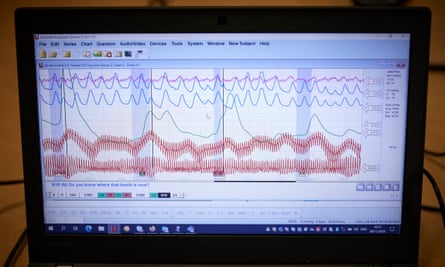“Did you plant the bomb?” It’s not a question I’ve been asked before but I’m comfortable enough denying it. Truth is – I didn’t plant a bomb. I planted a pretend bomb – a shoebox filled with webcams and wires – and I’m relying on my physiology to share the pedantic, but surely relevant, distinction. “No,” I answer. There is no bomb.
I’ve been told to look straight ahead at the wall so have no idea what Amanda – not her real name – makes of my response. A trainee polygraph examiner, she is hunched over a laptop monitoring my reaction to her questions via sensors on my hand, arm and around my chest. She tells me to sit still. The seat pad has detected a shuffle – a warning I may be deploying “countermeasures”. One such trick, I learn too late, is to firmly clench the buttocks.
There are 10 trainees on the course at Heaton Mount, a 19th-century mansion in leafy north Bradford, where police and probation officers attend lectures and practical sessions on the polygraph. They will use the procedure – lie detector tests – to help assess whether convicted sex offenders out on licence are complying with the conditions of their release.
The Ministry of Justice introduced compulsory lie detector tests for sex offenders in 2014. But now the controversial technique is poised to become more widespread in the British justice system.
The domestic abuse bill and the counter-terrorism and sentencing bill, both passing through the Lords, provide for regular, mandatory testing of domestic abuse offenders, suspected terrorists and convicted terrorists on release. While failing a test would not in itself mean prison time, fresh disclosures, investigations prompted by failed tests, attempting to beat the polygraph, refusing a test or remaining silent in a test, could all trigger a recall. Loss of liberty in such circumstances is determined not by court but by probation officers, the former lord chief justice, Lord Thomas, has noted. Tests are expected to start in the spring.
For Don Grubin, emeritus professor of forensic psychiatry at Newcastle University and director of Behavioural Measures which runs the Heaton Mount training course, the polygraph is a means of gaining fresh information, an additional tool to help manage offenders. “What you’re looking for is information to indicate there’s an increased risk,” he says. But debate in the Lords and beyond has raised serious questions around the polygraph’s place in the legal system.
Marion Oswald, vice-chancellor’s senior fellow in law at Northumbria University, calls the polygraph “an oppressive interrogation tool”, a phrase Grubin finds “over the top”. Oswald wants an immediate moratorium on polygraphs, an independent review of their usage across police forces and the probation service, and, if tests resume, continuing independent oversight. “There’s a really high risk of people relying too much on these polygraph outputs,” she says. But Grubin argues there’s no evidence of this being an issue, adding that the risk is no greater than for other measures, such as criminal record checks and tagging.
Polygraph equipment has come on since William Marston, creator of Wonder Woman and the “truth lasso”, dabbled with the technology in the 1920s. It has also become more of a palaver, particularly in a time of pandemic when the examiner is wearing full PPE.

First, twin “pneumotubes” are strapped around the chest and abdomen to record breathing rate. Then a blood pressure cuff is wrapped around the arm and inflated to monitor heart activity. After that, electrodes are attached to the index and ring fingers. These measure changes in skin conductance from imperceptible sweating. Then there is the photoplethysmograph, a device smaller than its name, which clips on the end of a finger to monitor blood flow. When all this is strapped, wrapped, clipped and dangling, the subject sits on a seat pad which detects movement – a potential sign the examinee is attempting to beat the test, or perhaps merely fidgeting in a session that can last three hours.
Before the test proper comes the pre-interview. The aim is to build a rapport with the examinee, but also to work up comparison questions that will get the subject thinking, partly by stimulating memories. In my case, these send me back through a Rolodex of past experiences. “Have you ever threatened anyone?” Daily, I have children. “Have you ever hurt anyone?” I admit to Chinese burns, the occasional dead leg, but what does it mean to hurt someone? We could be here all day.
Inevitable omissions cross my mind when the test is afoot. Success or failure depends on whether my physiological responses to questions about a bomb threat – performed under Grubin’s direction – are stronger than those to the comparison questions. Methods to beat the test often rely on inducing a response to the comparison questions – squeezing a drawing pin between your toes, for example – but Grubin suggests this is easier said than done: it takes practice and it helps to have a polygraph to hone the skill on.
In a real polygraph test, those deemed to have failed are asked to account for their apparent deception in a post-test interview. They could argue that the system is flawed or that the result is a false positive. But some choose to disclose fresh information, even breaches of their licence.
The science behind the polygraph is vague and contested. The equipment measures physiological responses, but responses to what, and the meaning of them, are open questions. The American Psychological Association says there is no evidence that any pattern of physiological responses is unique to deception, and while honest people might be nervous when answering truthfully, dishonest people might be calm liars. A lengthy review by the US National Research Council in 2003 found that a century of research had failed to make much headway on the science behind the polygraph. “It has not accumulated knowledge or strengthened its scientific underpinnings in any significant manner,” the report states.
Grubin believes the polygraph reveals the importance of a question to the individual under test, its emotional significance, and the cognitive work required if they lie when answering. “All of that ends up being seen in the physiological response,” he says. “It’s not detecting lies, and shouldn’t be thought of as a lie detector. It is an indicator of the salience of the question and the cognitive processing associated with it. It also encourages disclosures for reasons we don’t understand, and in that respect it might be thought of as a truth facilitator. In the end, test outcome and disclosure are both important, and complementary.”
In my case, even though I didn’t plant a real bomb, I did hide a pretend one under a staircase and write a bomb threat letter. According to Grubin, lying that I did so should show up in my physiological response. Sure enough, when my test is over I’m told I failed: my responses – chiefly the invisible sweating that increased the conductance of my skin – spiked when quizzed about planting the bomb and writing the threatening letter. But without knowing how I would have responded before the mock crimes, I can’t be sure I just care more about bombs than anything else I’m asked about.
The Ministry of Justice’s enthusiasm for polygraphs has been buoyed by their perceived success with sex offenders. In support of the “single issue tests” given to sex offenders it cites an 89% “decision accuracy rate” taken from an American Polygraph Association meta-analysis of 45 experiments and surveys. Prof Gershon Ben-Shakhar, an Israeli psychologist who has studied polygraphs for 50 years, argues that such accuracy estimates “are based on flawed studies and cannot be trusted”. But Grubin says the findings show polygraphs used in this way are “significantly better than chance”.
Other evidence appears to support their use. A University of Kent review of police testing in 2020 found polygraphed offenders and suspects were more likely than comparisons to reveal risk-relevant information, such as admissions of sexual interest in children, or increased access to them. Another review for the MoJ in 2012 was similarly positive, finding more “clinically significant” disclosures, while nearly half of those polygraphed said the tests made them more likely to abide by their licence conditions.
Grubin’s training course is accredited by the American Polygraph Association which sets standards and codes of practice. Trained examiners are supervised and the charts from their tests reviewed by Grubin or other practitioners.
Oswald likens the arrangement to the industry “marking its own homework” and is deeply uneasy about its role in UK justice. “The American Polygraph Association is not an independent scientific body, it’s a trade association, so there’s a link between commercial interests, the rollout of these tests, and the incorporation of these APA requirements in to UK law,” she says.
Another concern raised by the counter-terrorism and sentencing bill is the use of polygraphs to help assess whether terrorism suspects are complying with Tpim (Terrorism Prevention and Investigation Measures) notices. While polygraphs might contribute to decisions to tighten restrictions on terrorism suspects, they can equally be part of the evidence to relax them. “For me that’s a very worrying prospect,” says Oswald.
The government piloted polygraphs for sex offenders and will do the same for those convicted of domestic abuse. There is no pilot planned for counter-terrorism uses. When Lord Falconer, the shadow attorney general, called for such a pilot, Lord Wolfson, the parliamentary under-secretary of state for justice, said the sex offender pilot had already provided “extremely positive results” and there were too few terrorists for a trial to be meaningful. But Ray Bull, professor of criminal investigation at the University of Derby, points out that some sex offenders may confess bad behaviour because they don’t want to commit awful crimes. “The willingness to talk might be very different among terrorists,” he says.
Bull is concerned that even though polygraphs are only one tool used to assess offender behaviour, there will be a temptation to rely on the results. “It’s a topic for debate because the answers aren’t simple,” he says, on the use of polygraphs in the legal system. “It’s a bad idea if people over-believe in the effectiveness of polygraphs. We mustn’t stop thinking about, or developing, other ways to deter offenders.”
A Ministry of Justice spokesperson said: “Polygraph testing of sex offenders has helped to keep the public safe and these new laws provide another reliable tool to monitor terrorists released from prison and allow us to test whether it is equally effective with domestic abusers.
“Offenders are also subject to close supervision and behaviour treatment, with polygraph testing only used as an additional tool to ensure they are obeying strict limits on things like internet use, movements and contact with victims.”
The questions I faced

The polygraph test is given three times with the order of the questions changed on each occasion. The chart shows seat pad activity in magenta, breathing rate in blue, electrodermal activity (sweating) in green, heart activity (red) and blood flow (black). These are questions I faced.
Do you believe you’ll only be asked the questions we discussed?
Have you ever lied to your employer?
Did you write the letter today?
Have you ever threatened anyone?
Did you plant the bomb?
Have you ever hurt anyone?
Do you know where the bomb is now?










